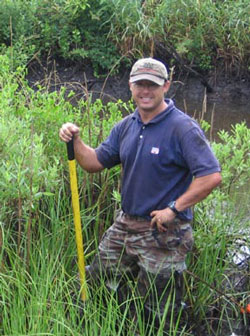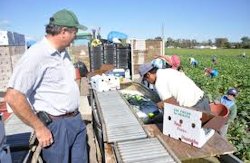Last of two parts
ENGELHARD — Hyde County, with its pancake-flat land, pocosin swamps and swarms of bugs, isn’t many peoples’ idea of paradise.
Supporter Spotlight
But to those who live, hunt and fish here, there’s no place prettier on Earth.
The Albemarle-Pamlico peninsula, on which the county sits, is rimmed on the east by Croatan and Pamlico sounds. It’s so remote and unpeopled that in the mid-1980s the U.S. Fish and Wildlife Service chose it as a site for the reintroduction of the red wolf, an eastern predator that had been driven to the brink of extinction.
Hyde residents tend to be self-sufficient and friendly toward outsiders—as long as the strangers don’t try to tell them how to live. They distrust the federal government and criticize what they consider interference on the part of environmental regulators.
The N.C. Coastal Federation arranged with Wilson Daughtry and his partners to build a major hydrologic restoration project on Lux Farms in northeast Hyde. They entered a bureaucratic labyrinth.
Project Goals
The federation’s goal is to work with farmers to restore the hydrology of ditched and drained land in a manner that both heals the natural system and provides improvements to farming operations. By storing water in diked impoundments, the farmer can have adequate irrigation for crops during the growing season. Drainage water that’s held back for irrigation won’t be pumped into the rich estuaries of Pamlico Sound.
Supporter Spotlight
Daughtry also worries that federal agencies will soon require farmers to control the amount of drainage water coming off their fields. “It’s happening already in Florida,” he said. He saw the hydrologic restoration project as a way of getting ahead of the curve — and getting grant money to help foot the bill.
The federation in 2008 received an $80,000 planning grant from the Clean Water Management Trust Fund to model current and historic drainage patterns and design a restoration project on Lux Farms that could be built in phases.
 Mike Burchell and his team at N.C. State University designed the project. Photo: NCSU |
To design the project, the partners tapped Michael Burchell and a team of engineers at N.C. State University’s Department of Biological and Agricultural Engineering. Burchell and company had done the design work at the federation’s restoration project at North River Farms in Carteret County. They worked up a plan to hold drainage water in three reservoirs within Lux Farms. Overflow would seep into a restored historic slough that flowed north toward the Alligator River National Wildlife Refuge.
Then in 2009 the bottom fell out.
State budget shortfalls caused the state trust fund to place a hold on grants for all its projects, including the planning for the first phase of Lux Farms.
At the same time, administrative road blocks stalled the acceptance of the project property into the federal Wetlands Reserve Program, which is part of the U.S. Department of Agriculture’s Natural Resources Conservation Service. The voluntary program pays easements to landowners who want to protect, restore and enhance wetlands on their property. Enrolling the Lux Farm property into the program was a requirement of the trust fund grant. No construction could move forward until the land was enrolled.
Another obstacle arose when Mike Bryant, the manager of the Alligator River refuge for the U.S Fish & Wildlife Service, questioned whether redirecting water north would harm the refuge’s diverse bottomland swamp forests. Such hydrologic trespass would not be allowed.
“We’ll be putting water back into its natural flow pattern,” said Erin Fleckenstein, a coastal scientist for the federation. “But we do need to be careful not to overwhelm the natural systems on the refuge.”
The design couldn’t be completed without modeling studies to show how much water would be released onto the refuge—and until water quality tests could measure the potential pollutant load.
Word Spreads
Fortunately, word of the Lux Farms project had attracted interest from other Hyde County farmers. Jamin Simmons, manager of Mattamuskeet Ventures Farm, just west of the Lux holdings, contacted the federation to see if a similar project was possible on his land.
 Creating habitat for shorebirds became one of the project’s later goal. Photo: U.S. Fish & Wildlife Service |
The U.S. Fish & Wildlife Service Southeast Atlantic Migratory Bird Office in Columbia had money available for the creation of bird habitat through a program called Partners for Fish and Wildlife. “We were looking to create marsh habitat,” remembered Kendall Smith, biologist for the office.
When the federation approached him about a possible project on Mattamuskeet Ventures, Smith initially didn’t think it would work. “We didn’t need any more habitat for waterfowl in Hyde County,” he said.
But he took another look at the language for the program “and realized it would also work for creating shorebird habitat.”
Within a year work was moving forward on shallow water impoundments on two 300-acre blocks of Mattamuskeet Ventures land. Simmons already had a pump available for the project, and the Fish & Wildlife provided $150,000 for building dikes and contouring the land to create ideal habitat for shorebirds. During the spring and fall migrations, drainage from farm operations would be pumped into the impoundments and held at optimum levels—rather than being funneled into canals for release into local waterways. Overflow from the project would be funneled into adjacent wetlands.
The project moved unusually quickly and was completed in the fall of 2010.
No one could quite believe the federation-farmer partnerships were yielding so much fruit. At a celebratory meeting in the Mattamuskeet Ventures hunting lodge, the two farmers, both wearing bemused smiles, sat looking at federation staff. “If you’d told me five years ago that I’d be working on something with this group,” Daughtry said, “I wouldn’t have believed you.”
Back in Business
The state trust fund in 2010 reinstated the planning grant for the hydrologic restoration project on Lux Farms. The agency also agreed to fund the first phase of the work, allocating $970,000 for the project.
But there was still the delicate matter of working out agreements with adjacent land holders, including the Alligator River refuge.
Modeling by the NCSU engineers had shown that the water seeping onto refuge lands from the project would be filtered by wetlands so thoroughly that its nutrient load would not hurt the refuge ecosystem.
Field surveys also had shown that farm pumping was causing subsidence in the peat soils of the refuge.
“There’s actually a water deficit that’s drying out the peat and causing problems,” said Fleckenstein. “This is an opportunity to rehydrate the swamps. But the amount of water released needs to be carefully monitored to make sure there aren’t any adverse effects.”
Unfortunately, the engineers had also realized that a 300-acre irrigation reservoir planned for Phase 1 would kill the trees in a swamp forest. Daughtry had hoped to flood the area to depths of four feet to provide irrigation for the fields just to the south.
Because of the high ecological value of the swamp forest, staff for the Natural Resource Conservation Service said they could not allow more than 18 inches of water to be held on the land. The realization was a blow to Daughtry’s hopes that the project would provide the farm with an adequate source of irrigation.
Bryant also insisted that some way be found to stop the release of water, should refuge staff determine that the added flow from the project was harming refuge lands.
 Wilson Daughtry, left, supervises workers on his farm. |
But could the refuge staff be assured that Daughtry would stop dumping drainage into the project area if asked? The relationship between the Lux Farms partners and the refuge staff had been strained by long-standing squabbles over hunting access on the farm property and the maintenance of shared roads. As the N.C. State engineers moved toward finishing the design, federation staff worried that the project would be derailed by their inability to assuage Bryant’s concerns.
Daughtry himself provided the solution. He suggested that his agreement with the Natural Resource Conservation Service for the wetlands contain a condition requiring Lux Farms to stop pumping water northward if the Fish & Wildlife determined that the project was harming refuge lands.
“Wilson has hung in there with us as we‘ve tried to develop the best design for all partners,” Fleckenstein said. “We’re lucky to have this relationship with him.”
In October, the federation signed a contract with Daughtry for work to begin the following year. The groundbreaking will culminate more than six years of planning.
Project’s Growth
What started as a project to restore oysters in Pamlico Sound has become much more. In addition to the original Fish & Wildlife shorebird habitat project, the Albemarle-Pamlico National Estuaries Program provided $99,000 for water quality monitoring and additional dike work to fine-tune the farm’s ability to hold water in one of the habitat blocks.
The state trust fund is providing $400,000 for a similar project that will redirect drainage water onto 1,350 acres that have been set aside in wetland program.
The U.S. Environmental Protection Agency’s has made $70,000 available for a Watershed Restoration Plan within the Mattamuskeet Drainage Association. Farmers, engineers, federation staff and other partners are working together to identify future water management projects. Their goal is to remove waterways from the state’s list of impaired waters by cutting down on the amount of runoff coursing through the drainage system.
The federation staff has become regulars in Hyde, a conservative county generally avoided by other environmentalists. Mac Gibbs, the county’s agricultural extension director, now serves on NCCF’s board of directors.
And Wilson and Debby Daughtry, the federation’s original partners in Hyde restoration, greet federation staff members warmly when they stop into the farm office for yet another chat. Not that Wilson, with his droll nature, is effusive in his praise. When asked recently if he were pleased by the progress of the Lux Farms work, he just grinned and rubbed his chin.
“Well,” he said, “I haven’t run you off. Yet.”








